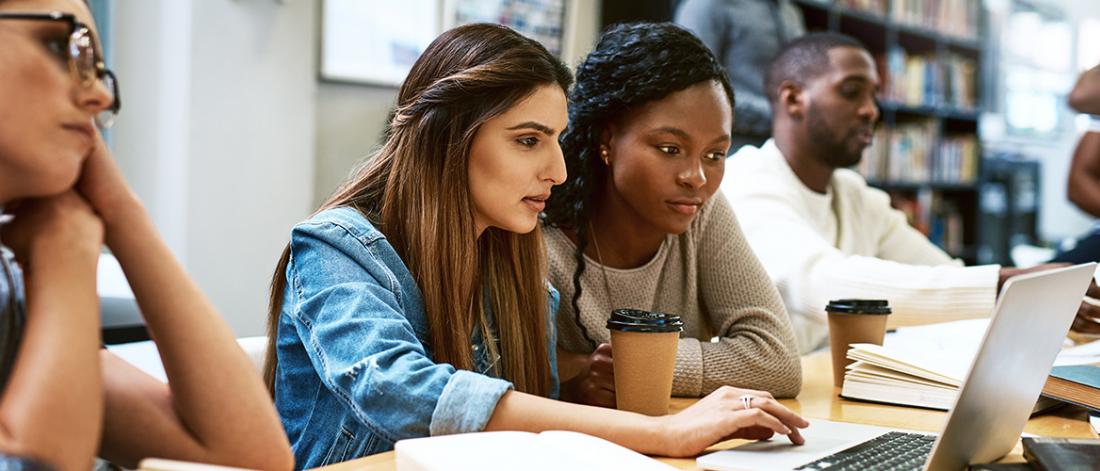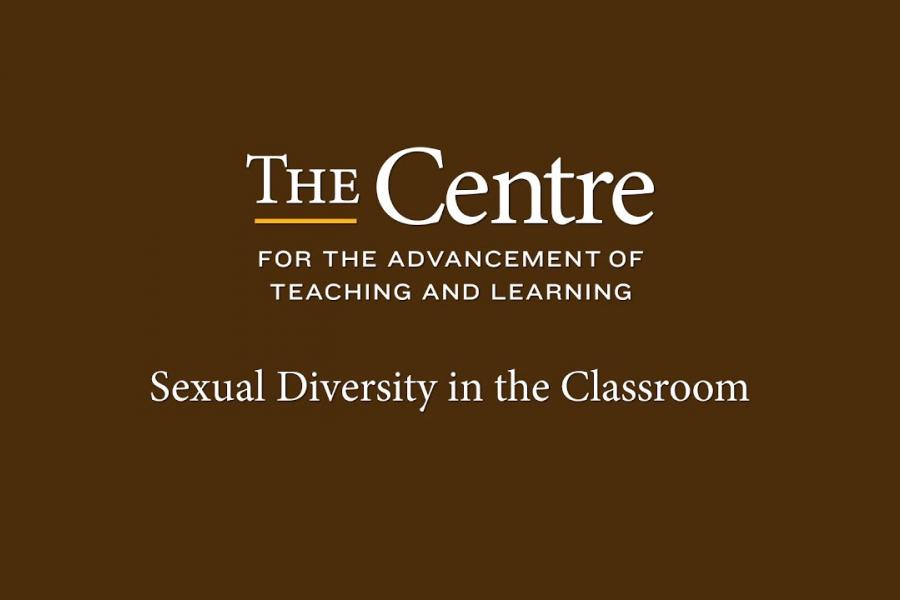Diversity and inclusion
For a student entering a post-secondary institution, feeling excluded or alone creates a significant barrier to their learning, especially when that exclusion is based on their identity (e.g., see Robson, 2013, chapter 7).

Introduction
Think of a time when you felt like an outsider. Perhaps it was a time when you moved to a new city or neighbourhood, or started up in a new school or workplace. Maybe you felt invisible, as though your existence didn’t matter. For a student entering a post-secondary institution, feeling excluded or alone creates a significant barrier to their learning, especially when that exclusion is based on their identity (e.g., see Robson, 2013, chapter 7).
Such discrimination will likely reach beyond the student’s life in the university. For example, an Indigenous student who feels a deep sense of alienation in their university experience as a result of widely-held racist perceptions will most likely also experience similar attitudes in their encounters with landlords, the health-care system, the justice system, in their past experiences with the school system, etc. (e.g., Henry, 2009) All of these barriers may compound to create struggles unimaginable to those living in the ‘mainstream.’ How can post-secondary teachers be expected to tackle such deeply-rooted problems?
One way is by simply addressing what is in our power – the interactions that happen in our classrooms.
Interview
General strategies
Inclusive Teaching Resources and Strategies (University of Michigan’s Center for Research on Learning and Teaching)
“This page features a range of online resources that define inclusive teaching and provide specific strategies for practicing it.”
Guidelines for Inclusive Teaching (Vanderbilt University’s Centre for Teaching)
This page provides an extensive list of guidelines to help facilitate diverse and inclusive post-secondary classrooms.
Dealing with ‘Hot Moments’ in the Classroom (Harvard University’s Derek Bok Center for Teaching and Learning)
‘Hot moments’ are those moments during a classroom discussion when a controversial statement leads to a strong emotional reaction (e.g., climate change is a hoax). Lee Warren provides practical strategies for managing ourselves and finding teaching opportunities that arise out of ‘hot moments.’
Creating Inclusive College Classrooms (University of Michigan’s Center for Research on Learning and Teaching)
As a post-secondary teacher it is important to have some awareness of your students, recognize the assumptions you may hold regarding various perceived identities (which are always more complex then they appear), and how those assumptions inform your actions. This process may allow you to critically reflect on assumptions about specific student identities with regards to what is assumed to be typical behaviour and capabilities. To view a sampling of assumptions to begin a critical examination of teacher-student interactions follow this link and scroll down to the subheading Increasing Awareness of Problematic Assumptions.
Racial and cultural diversity
Teaching in Racially Diverse College Classrooms (Harvard University’s Derek Bok Center for Teaching and Learning)
This executive summary provides concrete tip sheet with many helpful strategies.
Diversity Issues for the Instructor: Identifying Your Own Attitudes (University of Michigan’s Center for Research on Learning and Teaching)
“When we speak of multicultural dynamics in the classroom, we usually focus on the diversity of the students in the room. We often forget that the teacher also brings a range of diversity issues to the classroom.”
Gender issues
Gender Dynamics in the Classroom (Center for Teaching Excellence of the University of Virginia)
A succinct article that describes concrete ways to promote gender equality.
Sensitivity to Women in the Contemporary Classroom (Harvard University’s Derek Bok Center for Teaching and Learning)
Strategies to create an inclusive environment in the classroom for women.
Gender Issues in Teaching (Stanford University Newsletter on Teaching)
This thought-provoking article asks the question, “Does nurturing academic success in women mean rethinking some of what we do in the classroom?”
Sexual diversity
Tips for Teachers- Ally Yourself with LGBT students
A short article providing six tips to positively interact with LGBT students.
Suggestions to Incorporate Gay Lesbian Bisexual Transgender (GLBT) Subject Materials into Class Curriculum (University of Southern California Lesbian Gay Bisexual Transgender (LGBT) Resource Center)
Accessibility
Teaching Students with Disabilities (Vanderbilt University’s Centre for Teaching)
“Students of all abilities and backgrounds want classrooms that are inclusive and convey respect. For those students with disabilities, the classroom setting may present certain challenges that need accommodation and consideration.”
Introduction to Inclusive Teaching Practices (Centre for University Teaching, Teaching & Learning Support Service, University of Ottawa)
Resources for your students
Indigenous Student Centre
“Providing student support in a manner consistent with the culture and values of Aboriginal Peoples for the purpose of increasing/enhancing the accessibility and retention of Aboriginal students. The Indigenous Student Centre is dedicated to the creation of an educational environment that includes the affirmation of Aboriginal cultures, values, languages, history, and way of life by virtue of increasing the knowledge foundation offered at the University of Manitoba.”
University of Manitoba Aboriginal Students’ Assocation (UMASA)
“The University of Manitoba Aboriginal Students’ Association (UMASA) is a non-profit organization created to help support our students at the University of Manitoba. Our goal is to help make university life a pleasant one. The Aboriginal Students’ Association provides personal and moral support to all our members, Aboriginal and non-Aboriginal.”
Womyn’s Centre
“The University of Manitoba Womyn’s Centre is a queer-positive, pro-choice, feminist, non-hierarchical collective on campus, dedicated to challenging and organizing against sexism, racism, able-ism, classism, homophobia, age-ism, and fat-ism inside and outside of the university.” Office 190 Helen Glass; Email womynscoordinator@umsu.ca
Rainbow Pride Mosaic’s Facebook page
“Rainbow Pride Mosaic (RPM) is the University of Manitoba’s Gay, Lesbian, Bisexual, Trans-Gendered, Two-Spirited (LGBTT) and Straight Ally resource centre and student lounge. It provides peer support, referrals to other community resources, and a reference and lending library which include gay/lesbian films. RPM also offers a wide range of programming and events throughout the year, such as a member’s camping trip, fundraisers, movie nights and an LGBTT awareness week. RPM is committed to improving the quality of student life on campus for all LGBTT and Ally students, through awareness, safety initiatives, programming, ongoing education and visibility.” Office 180 Helen Glass Centre; Email rpm@umsu.ca
Rainbow Resource Centre
“The Rainbow Resource Centre is a not-for-profit community organization that provides support and resources to the gay, lesbian, bisexual, transgender and two-spirit communities of Manitoba and North Western Ontario.”
LGBT Awareness & Ally Training (A resource for students and instructors)
“Ally training prepares individuals to identify, speak out, and stand up for a person or group that is targeted and/or discriminated against based on sexual orientation, gender identity, and gender expression. Allies are people who do not necessarily identify as LGBTTQ (all people can be an Ally), but support the LGBTTQ community by standing up against homophobia, biphobia, transphobia and heterosexism so all people can live in a safer environment, community and society.”
Student Accessibility Services
“SAS provides support and advocacy for students with disabilities, such as: hearing, injury-related, learning, mental health, medical, physical, visual or temporary disabilities. We act as a liaison between students, faculty, staff and service agencies.”
Further readings
Case, K. (Ed.). (2013). Deconstructing privilege: teaching and learning as allies in the classroom. New York, NY: Routledge.
Ginsberg, M., & Wlodkowski, R. J. (2009). Diversity and motivation: Culturally responsive teaching in college (2nd ed.). San Francisco, Calif.: Jossey-Bass.
Henry, F. (2009). The colour of democracy: Racism in Canadian society (4th ed.). Toronto, ON: Harcourt Brace Canada.
hooks, bell. (1994). Teaching to transgress: Education as the practice of freedom. New York: Routledge.
hooks, bell. (2003). Teaching community: A pedagogy of hope. New York, NY: Routledge.
James, C. (2010). Seeing ourselves: Exploring ethnicity, race and culture (4th ed.). Toronto, ON: Thompson Educational.
Kinew, W. (2015). The reason you walk: A memoir. Toronto, ON: Viking.
King, T. (2012). The inconvenient Indian: A curious account of native people in North America. Toronto, ON: Doubleday Canada.
Robson, K. (2013). Sociology of education in Canada (1st ed.). Toronto, ON: Pearson Canada.
Saul, J. (2015). The comeback: How Aboriginals are reclaiming power and influence. Toronto, ON: Viking.
Truth Reconciliation Commission of Canada. (2015). Final report of the Truth and Reconciliation Commission of Canada. Volume one, Summary (Second printing]. ed.). Winnipeg, MB: James Lorimer & Company.

